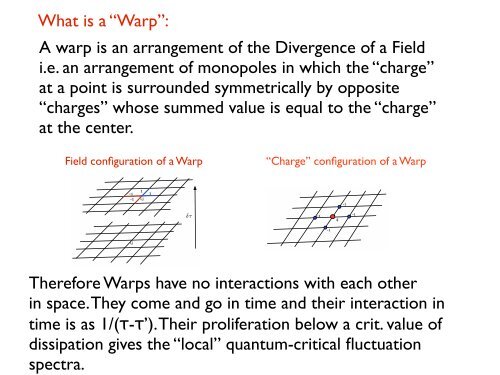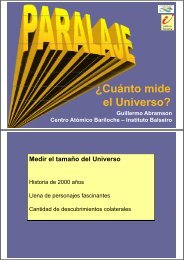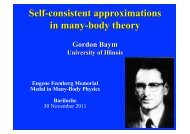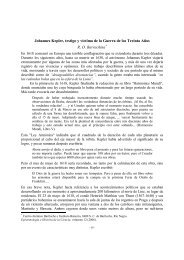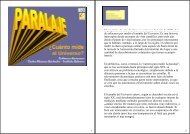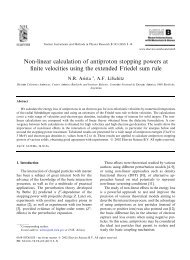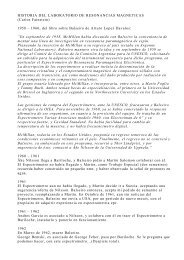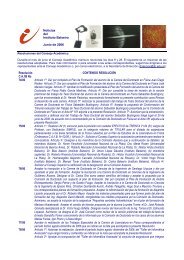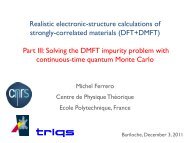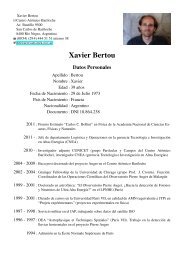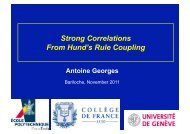Superconductivity through Quantum Critical Fluctuations in the ...
Superconductivity through Quantum Critical Fluctuations in the ...
Superconductivity through Quantum Critical Fluctuations in the ...
You also want an ePaper? Increase the reach of your titles
YUMPU automatically turns print PDFs into web optimized ePapers that Google loves.
What is a “Warp”:A warp is an arrangement of <strong>the</strong> Divergence of a Field at a po<strong>in</strong>t is surrounded symmetricallyFor a general vector field oneby does expectoppositetwo k<strong>in</strong>ds of“charges” whose summed value is equal to <strong>the</strong> “charge”vortices, <strong>the</strong> additional topological entity to describe <strong>the</strong>at <strong>the</strong> center.FIG. 3: A phase slip between nearest neighbors <strong>in</strong> time producesa vortex and an antivortex on neighbour<strong>in</strong>g plaqiettes.In time one bond has acquired a nonzero value, representedby <strong>the</strong> red bond. If <strong>the</strong> value on <strong>the</strong> bond is -1, <strong>the</strong> vorticityat site 1 is negative and on site 2 is positive.ThereforeFIG. 4: A phase slipWarpsevent <strong>in</strong> rime resultshave<strong>in</strong> a changeno<strong>in</strong> <strong>the</strong><strong>in</strong>teractionssurrounded at <strong>the</strong>by four annearest equalneighbor butwithopposite sites. Incharge eachgeneraldistributed<strong>the</strong> magnitudeo<strong>the</strong>rl<strong>in</strong>k variables. For a change of 2π at site {i, j}, <strong>the</strong>fourl<strong>in</strong>ksof<strong>the</strong> divergence at <strong>the</strong> site will equal to <strong>the</strong> number of nearestconnected to it acquire <strong>the</strong> values shown <strong>in</strong> <strong>the</strong> figure.timeThusis a phase slip1/(τ-τ’).on a l<strong>in</strong>k is equivalentTheirto a localproliferation<strong>in</strong> are most one latticebelowspac<strong>in</strong>g apart; <strong>the</strong>a<strong>in</strong>teractioncrit. valueisoflocal <strong>in</strong> space. Although this is physically obvious fromdissipation gives <strong>the</strong> “local” quantum-critical fluctuationnext section.ρ i ps Θ (τ − τ i) [(̂x + ŷ) δ (r − r ij )spectra.Field configuration of a Warpspace and time vortex current.Local phase slips and WarpsThe periodic <strong>in</strong> time boundary condition allows forδτ− ŷδ (r − r ij − aŷ)] Θ (τ − τ i )Such a vector field distribution has no curl and hence doesnot effect <strong>the</strong> vorticity. On <strong>the</strong> o<strong>the</strong>r hand <strong>the</strong> divergencei.e. an arrangement ofδτmonopoles <strong>in</strong> which <strong>the</strong> “charge”is nonzero and phase slip events generate field configurationsthat are orthogonal to those created by vortices.sources to generate an arbitrary distribution. For <strong>the</strong>2+1 dimensional quantum model we have, besides <strong>the</strong>w<strong>in</strong>d<strong>in</strong>g number sector <strong>in</strong> time. Events that change <strong>the</strong>w<strong>in</strong>d<strong>in</strong>g number sector, i.e. local phase slips, acts assources for a divergence <strong>in</strong> <strong>the</strong> vector field. Just as avortex is equivalent to an electric charge <strong>in</strong> <strong>the</strong> dual language,<strong>the</strong> sources created by phase slips can be shownto be a local distribution of monopoles (ρ m ). Given <strong>the</strong>“Charge” configuration of a Warpdistribution <strong>in</strong> eqn.15, <strong>the</strong> correspond<strong>in</strong>g configuration ofmonopoles, which we term <strong>the</strong> charge of <strong>the</strong> phaseslip isρ m (r, τ) = ∇ · m(r, τ) (16)= [4δ (r − r ij ) − δ (r − r ij + âx)− δ (r − r ij − âx) − δ (r − r ij + aŷ)− δ (r − r ij − aŷ)] Θ (τ − τ i )The monopole distribution equivalent to a phaseslip isshown <strong>in</strong> fig.5. The total monopole charge of <strong>the</strong> configurationis zero. S<strong>in</strong>ce <strong>the</strong> distribution has azimuthalFIG. 5: Warps are configurations of <strong>the</strong> field m with f<strong>in</strong>itesymmetry all harmonics are zero. This is <strong>the</strong> two dimensionallattice {i, j}, <strong>the</strong> realization divergenceof has <strong>the</strong>a configuration magnitude of 4 of at a<strong>the</strong> charge site anddivergence but no curl. For a warp of unit strength at site-1over a spherical shell of radius a <strong>in</strong> three dimensions. Themagnetic neighbors field due on <strong>the</strong> to <strong>the</strong> lattice. charges is conf<strong>in</strong>ed with<strong>in</strong> one<strong>in</strong> space. They come and go <strong>in</strong> time and <strong>the</strong>ir <strong>in</strong>teraction <strong>in</strong>unit cell around <strong>the</strong> site of <strong>the</strong> phase slip and is zero outside.Thus two phase slip events can <strong>in</strong>teract only if <strong>the</strong>ythis discussion, ∇×m t we (r, will τ) = demonstrate ρ v (r, τ) this explicitly <strong>in</strong> <strong>the</strong> (18)m l (r, τ) = ∑Phase slip events generateia local vortex current whichis divergenceless but has − âxδ f<strong>in</strong>ite (r − rcurl.ij − âx)−ŷδ (r − r ij − aŷ)]5In Fourier space we getm t (k, ω n ) = ıẑ × kk 2 ρ v (k, ω n )( ) 1 − e−ık x a ̂x +m l (k, ω n ) =ıωρ ps (k, ω n ) = ∑ iρ i pse −ık·r i−ıThe locality <strong>in</strong> space is reflfactors (1 − exp (−ık x a)) andk x a, k y a ≪ 1, to lead<strong>in</strong>g orderm l (k, ω n ) ≈ a (k x̂x +ω nThe two components of <strong>the</strong> fieonal to each o<strong>the</strong>r. Compar<strong>in</strong>gnent of m l generated by a phalength limit and a warp (eqn.portional to each o<strong>the</strong>r. In papartition function can be recas


